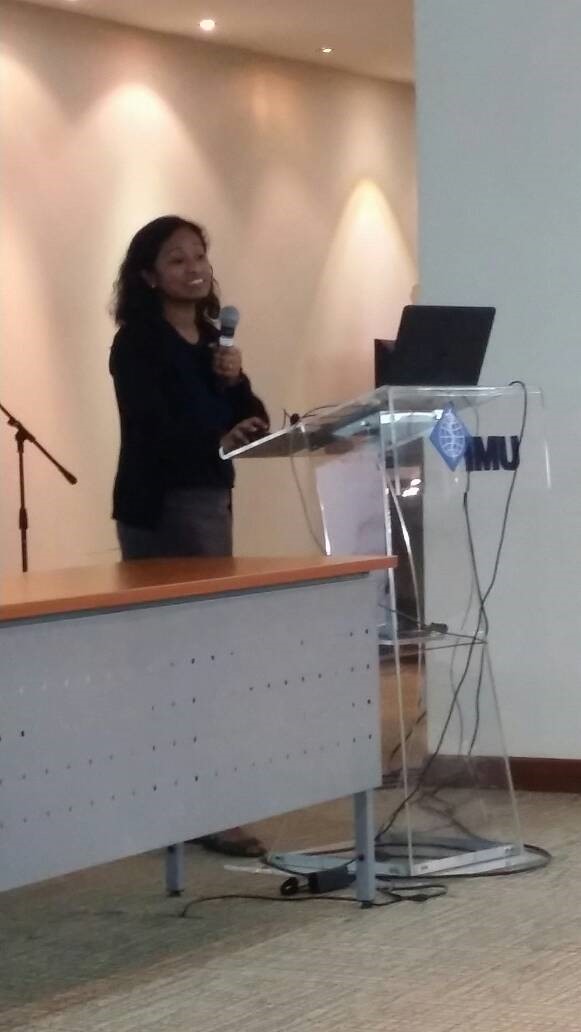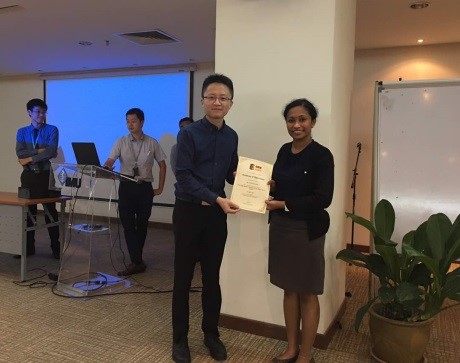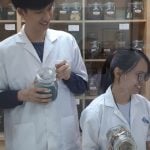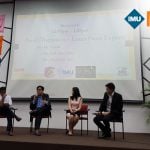31 May 2017 – A talk entitled “The Fight Against Staphylococcus. Where Do We Stand?” was held at the IMU Bukit Jalil Campus. The speaker, who is one of IMU’s Alumna, Anitha Ramadas shared her experience on what is currently happening at hospitals and what do healthcare professionals usually do in order to rectify this situation.
Anitha graduated with the IMU Bachelor of Pharmacy (Hons) programme in 2011. Currently, she is working as a clinical pharmacist in Hospital Kuala Lumpur (HKL) and her job scope is closely related to infectious diseases. She is also one of the contributors for the National Antibiotics Guideline 2014 and is taking part in the Antimicrobial Stewardship Programme in HKL.
The talk started with an introduction to Staphylococcus sp. The Staphylococcus sp. shows gram positive cocci under gram stain and it is in cluster form. It is commensal and usually presented on skin and is not infectious. However, it can be pathogenic when entering the blood and will eventually lead to bacteraemia, infective endocarditis and osteoarticular infections. Fatality is the worst consequence of the infections. It is difficult to clear the bacteria due to the resistance towards antibiotics. In addition, it is easily transmitted by having close contact with patients in hospital and community settings.  Approximately 30% of human population is colonised with Staphylococcus sp. There are four strains of Staphylococcus sp. which are methicillin-susceptible Staphylococcus aureus (MSSA), methicillin-resistant S.aureus (MRSA), vancomycin-intermediate S. aureus (VISA) and vancomycin-resistant S. aureus (VRSA). There have been many reports of MSSA, MRSA and VISA while only one case has been reported for VRSA. Cloxacillin is one of the first line treatments for MSSA as it is considered as a narrow spectrum. On the other hand, MRSA is resistant to cloxacillin but susceptible to vancomycin. In Malaysia, the resistance is tested as per CLSI breakpoints. There are two tests available for testing the efficiency of antibiotics towards the bacteria, which are zone of inhibition and E test. In zone of inhibition, the diameter of clear zone is being measured and the larger the diameter, the more efficient the antibiotics. For E test, the minimum inhibitory concentration (MIC) decides whether the bacteria are resistant or susceptible to the antibiotics. The gram negative bacteria become resistant by producing enzyme to hydrolyse antibiotics or developing barrier on cell wall to prevent the antibiotics from moving in. On the contrary, gram positive bacteria such as S. aureus undergo gene modification to become resistant to antibiotic.
Approximately 30% of human population is colonised with Staphylococcus sp. There are four strains of Staphylococcus sp. which are methicillin-susceptible Staphylococcus aureus (MSSA), methicillin-resistant S.aureus (MRSA), vancomycin-intermediate S. aureus (VISA) and vancomycin-resistant S. aureus (VRSA). There have been many reports of MSSA, MRSA and VISA while only one case has been reported for VRSA. Cloxacillin is one of the first line treatments for MSSA as it is considered as a narrow spectrum. On the other hand, MRSA is resistant to cloxacillin but susceptible to vancomycin. In Malaysia, the resistance is tested as per CLSI breakpoints. There are two tests available for testing the efficiency of antibiotics towards the bacteria, which are zone of inhibition and E test. In zone of inhibition, the diameter of clear zone is being measured and the larger the diameter, the more efficient the antibiotics. For E test, the minimum inhibitory concentration (MIC) decides whether the bacteria are resistant or susceptible to the antibiotics. The gram negative bacteria become resistant by producing enzyme to hydrolyse antibiotics or developing barrier on cell wall to prevent the antibiotics from moving in. On the contrary, gram positive bacteria such as S. aureus undergo gene modification to become resistant to antibiotic.
Three types of infections were being discussed in this talk, included skin and soft tissue infections, lung infections and bacteraemia. One of the tips in treating infections is to emphasise on the treatment of source (source control) followed by antibiotics as antibiotics treatment without source control will cause resistance to happen and increase the chance of relapse of infections. A few cases have been given by the speaker with a few options and a discussion was carried out to decide the most suitable option for that particular case.
There was a Question and Answer session followed by a kahoot session after the talk. The top 5 winners were awarded with prizes by Mark Cheong, the advisor of Young Pharmacist Chapter (YPC). Anitha was presented with a Certificate of Appreciation by Lim Shi Hao, the Chairperson of YPC and the talk successfully ended around 9.00pm. 









